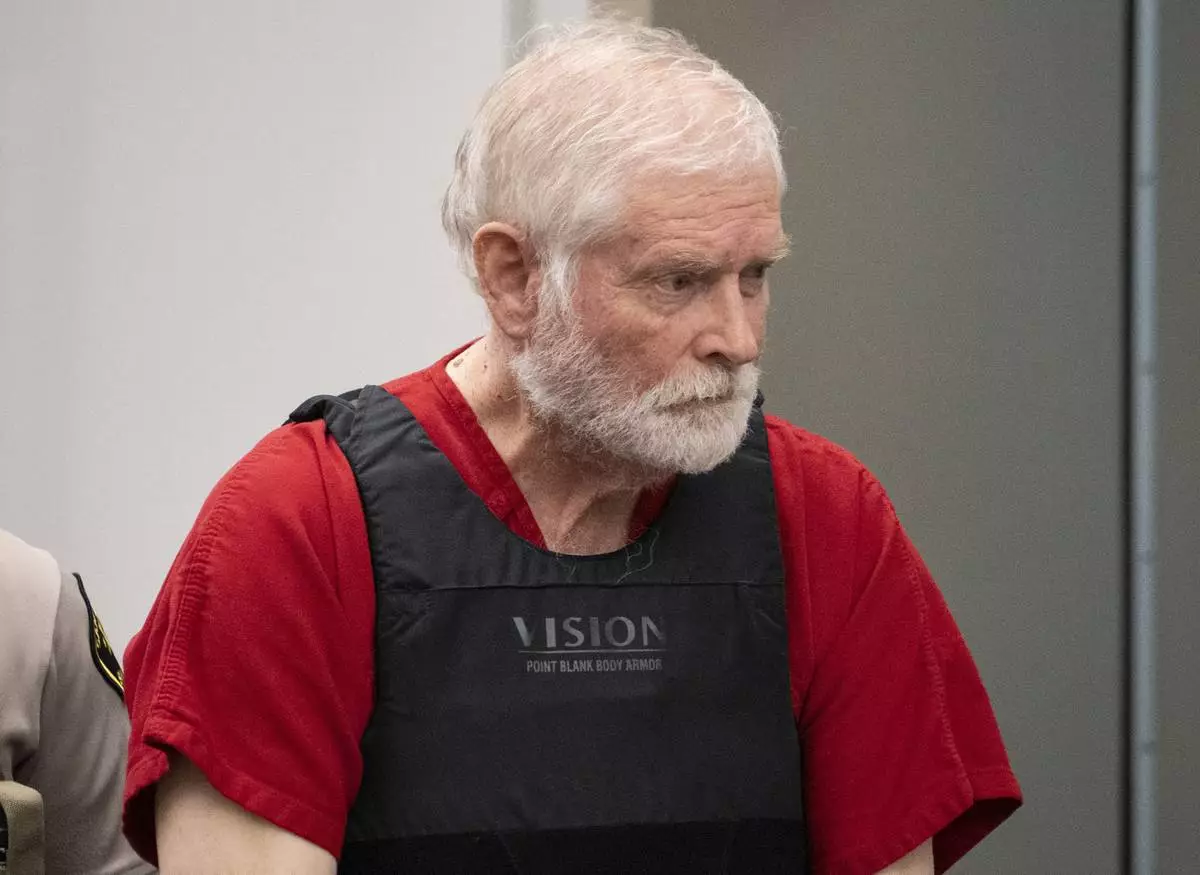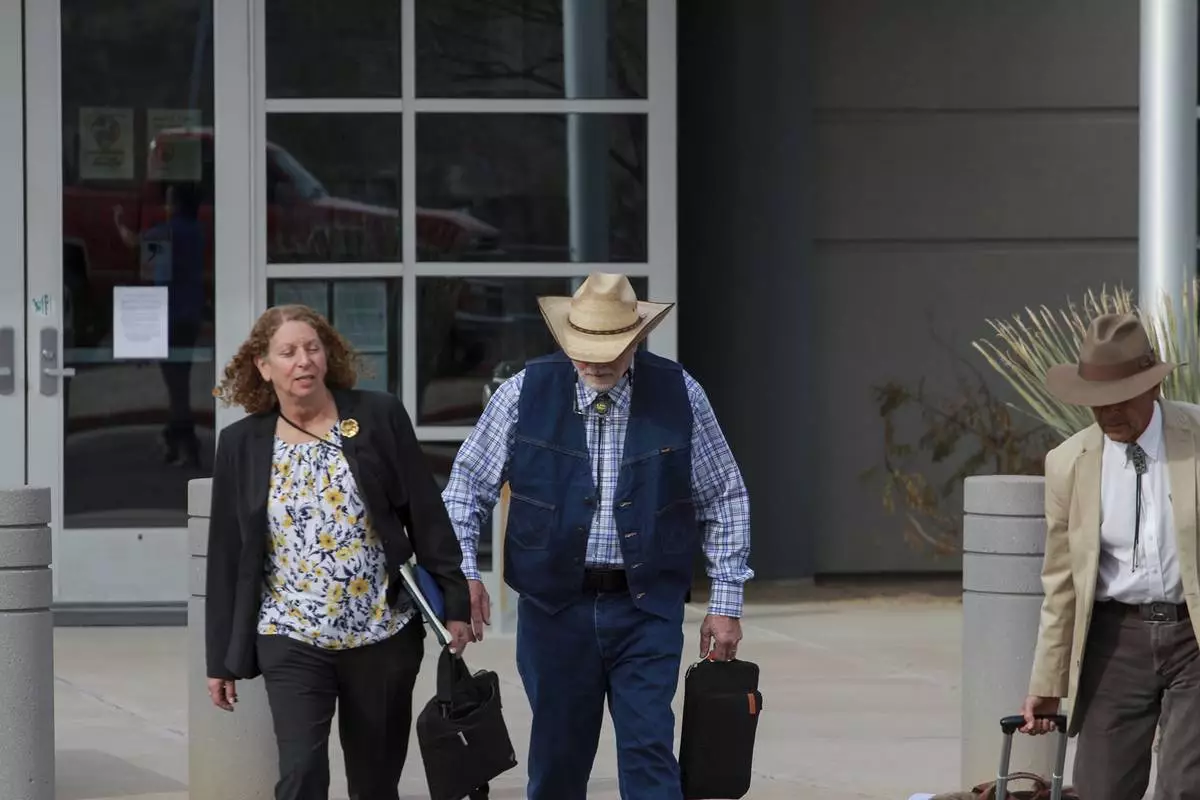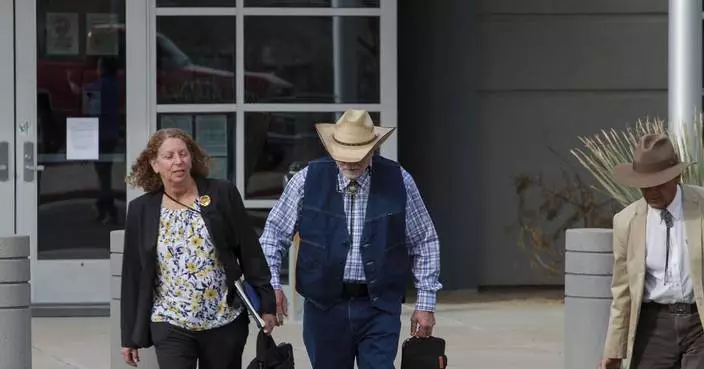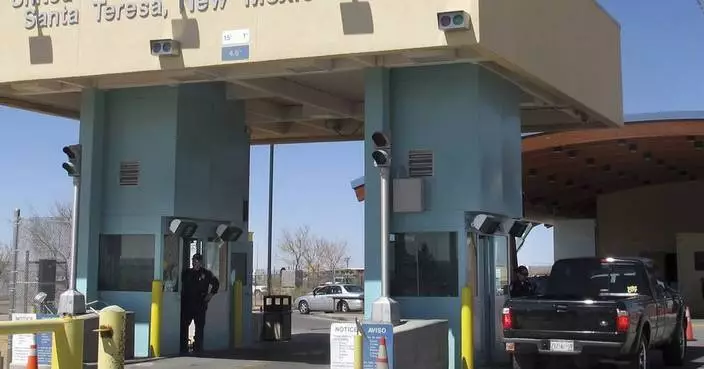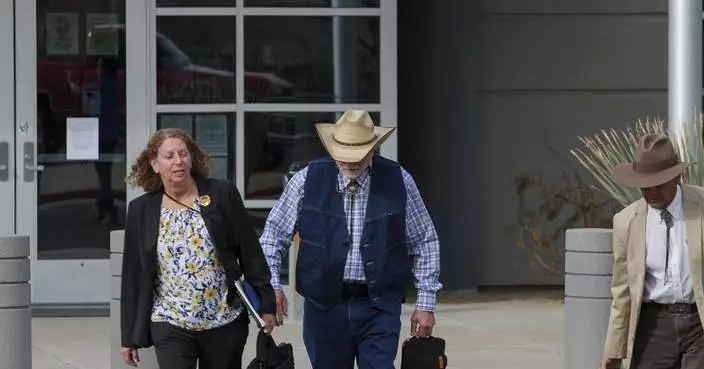The U.S. National Guard faces a vastly different environment than it did on its last two deployments to the border with Mexico, with far fewer illegal crossings and more Central Americans than Mexicans coming.
Still, its role is shaping up much the same: moving more Border Patrol agents from behind-the-scenes jobs to the front lines.
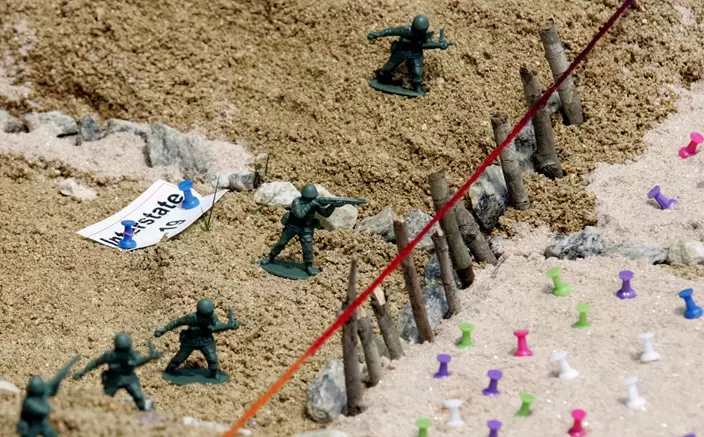
FILE - In this July 11, 2006, file photo, members of the Virginia National Guard constructed this sand map of the Nogales corridor in Nogales, Texas, depicting Guard deployments at the border during a training exercise for the Virginia National Guard volunteers who are being deployed to the Arizona border with Mexico at Fort Pickett in Blackstone, Va. Operation Jump Start, from May 2006 to July 2008, sent 6,000 troops to the border in its first year and 3,000 the second year and was framed as a way to buy time amid an unprecedented Border Patrol hiring spree and heavy political pressure for immediate action. The Border Patrol ballooned by thousands of agents during the operation to about 20,000, roughly where it is today. (AP Photo/Steve Helber, File)
President Donald Trump told reporters Thursday that he wants to send between 2,000 and 4,000 National Guard members to the U.S.-Mexico border to help federal officials fight illegal immigration and drug trafficking. That estimate is lower than the 6,400 Guard members that former President George Bush sent to the border.
From 2006 to 2008, the Guard fixed vehicles, maintained roads, repaired fences and performed ground surveillance. Its second mission in 2010 and 2011 involved more aerial surveillance and intelligence work. People involved in both operations say the Guard was the Border Patrol's "eyes and ears."
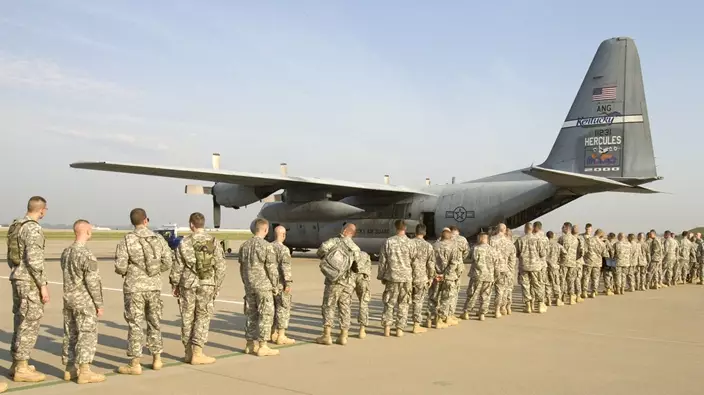
FILE - In this July 10, 2006, file photo, members of the Kentucky National Guard 206th Engineer Battalion board a C-130 transport plane at the Kentucky Air National Guard base in Louisville, KY. The 206th is being deployed to the Arizona border to build roads, fences and vehicle barriers to assist border security. The U.S. National Guard faces a vastly different landscape than it did on its last two deployments to the Mexican border but its role is shaping up much the same: moving Border Patrol agents from behind-the-scenes jobs to making arrests on the front lines. (AP Photo/David Harpe, File)
Federal law limits military involvement in civilian law enforcement, creating a supporting role for the Guard. The Trump administration and governors haven't said precisely what the troops will do, but Homeland Security Secretary Kirstjen Nielsen anticipates vehicle maintenance and aerial surveillance will be in the mix.
Operation Jump Start, from May 2006 to July 2008, sent 6,000 troops to the border in its first year and 3,000 the second year and was framed as a way to buy time amid an unprecedented Border Patrol hiring spree and heavy political pressure for immediate action. The Border Patrol ballooned by thousands of agents during the operation to about 20,000, roughly where it is today.
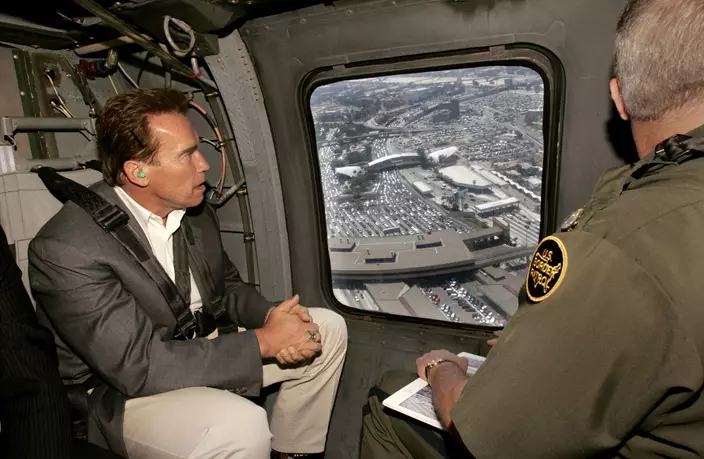
FILE - In this June 21, 2006, file pool photo, California Gov. Arnold Schwarzenegger, left, looks down on the International border crossing at San Ysidro, Calif., with Darryl Griffin, chief of the San Diego Sector, U.S. Customs and Border Protection during an aerial tour of the border between San Diego and Mexico in advance of the anticipated July 15 arrival of National Guard troops at the border. (Howard Lipin/The San Diego Union-Tribune via AP, Pool, File)
About 40 percent of troops went to Arizona, the busiest corridor for illegal crossings at the time, followed in order by Texas, California and New Mexico. The Border Patrol made about 1.1 million arrests the year Jump Start began, nearly four times what it did last year.
The Guard was assigned to observation posts some distance from the border for safety reasons, using binoculars and other gear to spot people crossing. Richard Barlow, then a top Border Patrol official in San Diego, said their success as lookouts varied because they were unarmed and needed protection in more dangerous areas.
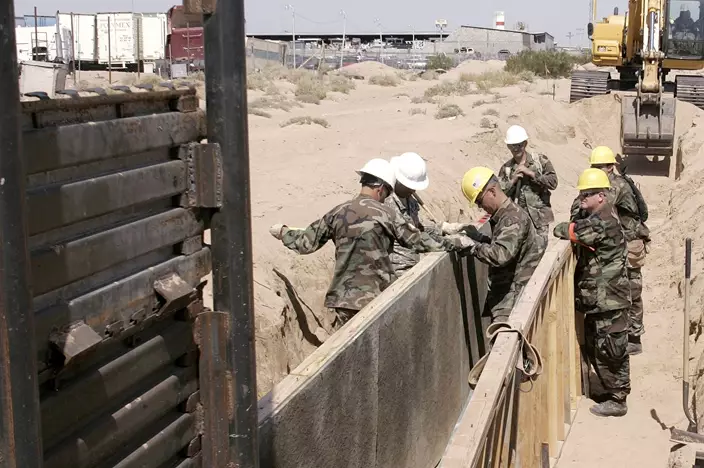
FILE - In this June 5, 2006, file photo, Utah National Guard troops from the 116th Construction Equipment Support Company prepare to extend a wall along the U.S. border in San Luis, Ariz. The soldiers are the first National Guard unit along the border as part of Operation Jump Start. Operation Jump Start, from May 2006 to July 2008, sent 6,000 troops to the border in its first year and 3,000 the second year and was framed as a way to buy time amid an unprecedented Border Patrol hiring spree and heavy political pressure for immediate action. The Border Patrol ballooned by thousands of agents during the operation to about 20,000, roughly where it is today. (AP Photo/Khampha Bouaphanh, File)
"They aren't allowed to have contact (with people arrested), so they're basically eyes," Barlow said.
Arrests had fallen by about half and hundreds of miles of border barriers were added by May 2010, when Operation Phalanx sent 1,200 troops to the border amid backlash to the killing of an Arizona rancher. Crossers were still largely Mexican men entering the country through Arizona deserts.
The Guard flew planes at high altitudes to identify people crossing, said Barlow, then the Border Patrol's top agent in Tucson, Arizona. It also responded by helicopter to agents who asked for help when closing in on a group.

FILE - In this June 8, 2006, file photo, members of the National Guard work on construction of a border wall at the U.S.-Mexico border next to San Luis Rio Colorado, Mexico. Photo was taken from a few steps into the United States. The arrival of U.S. National Guard troops in Arizona has scared off illegal Mexican migrants along the border as a whole, significantly reducing crossings, according to U.S. and Mexican officials. From 2006 to 2008, the Guard fixed vehicles, maintained roads, repaired fences and performed ground surveillance. (AP Photo/David Maung, File)
A bigger focus on intelligence work involved mining for trends and collaborating with investigators from other agencies, Barlow said.
Since then, crossings have shifted to Central American women and children crossing in Texas' Rio Grande Valley, many of whom turn themselves in to authorities and seek asylum or other protection. Mexicans accounted for only about four of every 10 arrests last year, down from about nine of 10 during the Guard's previous deployments.
A shared border means Mexicans can often quickly be turned around, but the Border Patrol holds Central Americans until another agency takes custody, typically within three days.
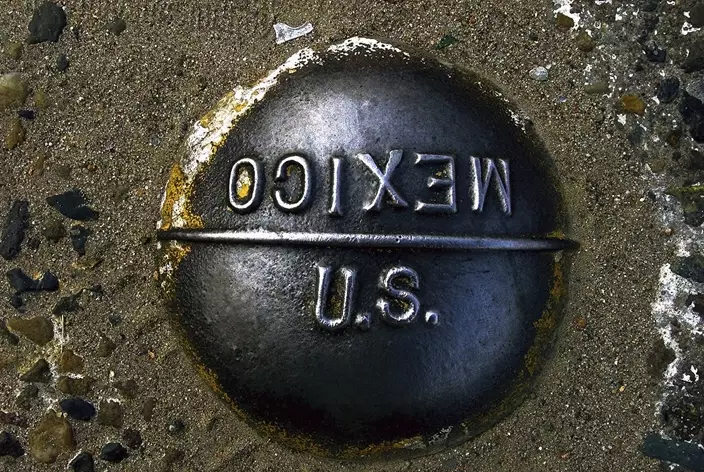
FILE - In this April 10, 2000, file photo, a marker embedded in the pavement marks the imaginary line between the United States and Mexico at the San Ysidro border checkpoint between San Diego, Calif., and Tijuana, Mexico. The rare conjunction of two major cities, Tijuana and San Diego, with Los Angeles to the north, make it one of the busiest border crossings on the planet. The U.S. National Guard faces a vastly different environment than it did on its last two deployments to the border with Mexico, with far fewer illegal crossings and more Central Americans than Mexicans coming. (AP Photo/Damian Dovarganes, File)
"The numbers are the numbers, but the type of numbers is what's critically important today," said David Aguilar, Border Patrol chief during the Guard's first deployment and deputy commissioner of parent agency Customs and Border Protection during the second.
Then-Border Patrol Chief Mark Morgan testified in 2016 that he never imagined his job would entail procuring baby powder and baby wipes. Agents' tasks include ensuring burritos are served at the right temperature.
"It takes a tremendous amount of resources to do this," Morgan said.

FILE - In this May 16, 2006, file photo, California Gov. Arnold Schwarzenegger, left, talks with Major Gen. William Wade II, the Adjutant General of the California National Guard, right, during a briefing on possible guard troop deployment along the border with Mexico, at the Capitol in Sacramento, Calif. Wade, accompanied by Col. David Baldwin, third from right, and Capt. Ty Shepard, were among the members of the National Guard assisting Wade in outlining the National Guards capabilities in fulfilling President Bush's plans to deploy National Guard troops along the border with Mexico to stem the flow of illegal immigrants. The U.S. National Guard faces a vastly different landscape than it did on its last two deployments to the Mexican border but its role is shaping up much the same: moving Border Patrol agents from behind-the-scenes jobs to making arrests on the front lines. (AP Photo/Rich Pedroncelli, File)
Aguilar, who retired in 2013, said he expected the Guard to take on surveillance work again — this time by air, ground and water. It's unclear if federal law allows troops to run detention facilities, but Aguilar doesn't see that happening.
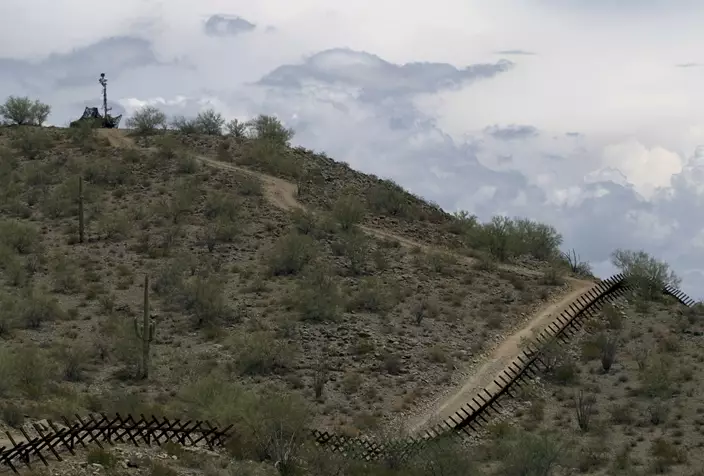
FILE - In this July 29, 2010, file photo, a U.S. National Guard vehicle guards covered under camouflage fabric sits atop a mountain next to the border fence near Sonoyta, Mexico. The U.S. National Guard faces a vastly different landscape than it did on its last two deployments to the Mexican border but its role is shaping up much the same: moving Border Patrol agents from behind-the-scenes jobs to making arrests on the front lines. Arrests had fallen by about half and hundreds of miles of border barriers were added by May 2010, when Operation Phalanx sent 1,200 troops to the border amid backlash to the killing of an Arizona rancher. Crossers were still largely Mexican men entering the country through Arizona deserts. (AP Photo/Guillermo Arias)
"Is (the Department of Defense) and National Guard equipped to do that, trained to do that?" he said. "Just like the Border Patrol, the answer is no, nor should they be encumbered with those responsibilities. That's not what our military does."
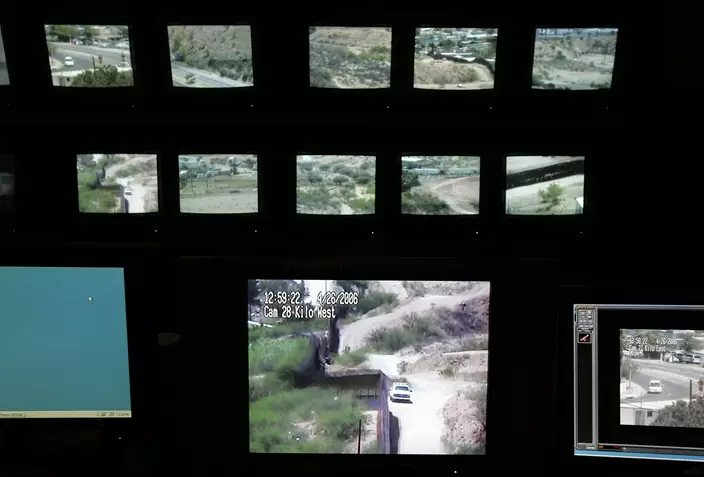
FILE - In this April 26, 2006., file photo, screens for surveillance cameras show various points along the border between Nogales, Mexico, and Nogales, Ariz., in a U.S. Border Patrol station in Nogales, Ariz. The U.S. National Guard faces a vastly different landscape than it did on its last two deployments to the Mexican border but its role is shaping up much the same: moving Border Patrol agents from behind-the-scenes jobs to making arrests on the front lines. (AP Photo/Gregory Bull, File)



